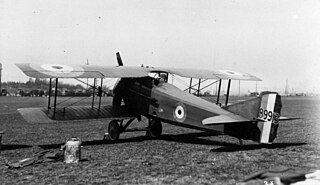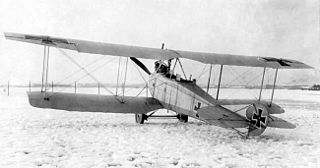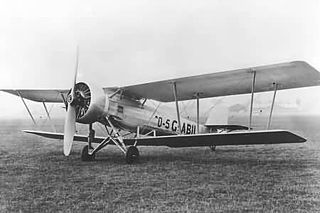| C.VII | |
|---|---|
 | |
| AGO C.VII in side view | |
| Role | Reconnaissance |
| Manufacturer | AGO Flugzeugwerke |
| First flight | 1916 |
| Status | prototype only |
| Number built | 1 |
The AGO C.VII was a prototype German reconnaissance aircraft of World War I.
| C.VII | |
|---|---|
 | |
| AGO C.VII in side view | |
| Role | Reconnaissance |
| Manufacturer | AGO Flugzeugwerke |
| First flight | 1916 |
| Status | prototype only |
| Number built | 1 |
The AGO C.VII was a prototype German reconnaissance aircraft of World War I.
In the C.VII, AGO attempted to improve upon its C.IV design by revising the wing bracing. The vertical fun and rudder were similar to that seen on the AGO C.V and AGO C.VI. [1]
After the end of World War I, the sole C.VII prototype was sold the Estonian Air Force. [1]

The Fokker D.VII was a German World War I fighter aircraft designed by Reinhold Platz of the Fokker-Flugzeugwerke. Germany produced around 3,300 D.VII aircraft in the second half of 1918. In service with the Luftstreitkräfte, the D.VII quickly proved itself to be a formidable aircraft. The Armistice ending the war specifically required, as the fourth clause of the "Clauses Relating to the Western Front", that Germany was required to surrender all D.VIIs to the Allies. Surviving aircraft saw much service with many countries in the years after World War I.

The Armstrong Whitworth A.W.38 Whitley was one of three British twin-engined, front line bomber types that were in service with the Royal Air Force (RAF) at the outbreak of the Second World War. Alongside the Vickers Wellington and the Handley Page Hampden, the Whitley was developed during the mid-1930s according to Air Ministry Specification B.3/34, which it was subsequently selected to meet. In 1937, the Whitley formally entered into RAF squadron service; it was the first of the three medium bombers to be introduced.

The Bristol Bulldog was a British Royal Air Force single-seat biplane fighter designed during the 1920s by the Bristol Aeroplane Company. More than 400 Bulldogs were produced for the RAF and overseas customers, and it was one of the most famous aircraft used by the RAF during the inter-war period.

The SPAD S.VII was the first of a series of highly successful biplane fighter aircraft produced by Société Pour L'Aviation et ses Dérivés (SPAD) during the First World War. Like its successors, the S.VII was renowned as a sturdy and rugged aircraft with good climbing and diving characteristics. It was also a stable gun platform, although pilots used to the more manoeuvrable Nieuport fighters found it heavy on the controls. It was flown by a number of the famous aces, such as France's Georges Guynemer, Italy's Francesco Baracca and Australia's Alexander Pentland.

The Siemens-Schuckert D.IV was a late-World War I fighter aircraft from Siemens-Schuckert (SSW). It reached service too late and was produced in too few numbers to have any effect on the war effort.

The Vickers Vildebeest and the similar Vickers Vincent were two very large two- to three-seat single-engined British biplanes designed and built by Vickers and used as light bombers, torpedo bombers and in army cooperation roles. First flown in 1928, it remained in service at the start of the Second World War, with the last Vildebeests flying against Japanese forces over Singapore and Java in 1942.

The Aviatik C.I was an observation aircraft which came into service during World War I in April 1915. It was a development of the Aviatik B.I and B.II models, being one of first aircraft of the new German C class of armed biplanes. In the C.I the observer sat in front of the pilot, with a machine-gun clipped on a sliding mounting fitted on a rail at either side of the cockpit. It gave the crew the means to attack enemy aircraft. The positions of the pilot and observer were reversed in last series of 50, ordered in 1917 solely for trainer purpose. There was only one aircraft built of refined C.Ia version in May 1916, with armament still in a forward cab, serving as a prototype for C.III. Later models of the plane included the Aviatik C.II and the C.III, which had more powerful engines. The C.III was produced in large numbers.
Luft-Fahrzeug-Gesellschaft, also referred to as LFG, was a German aircraft manufacturer during World War I. They are best known for their various "Roland" designs, notably the Roland C.II Walfisch (whale), Roland D.II haifisch (Shark) and Roland D.VI, although they also produced a number of airships and many experimental designs.

The AGO C.IV was a First World War German biplane reconnaissance aircraft.

The Avro Avian was a series of British light aircraft designed and built by Avro in the 1920s and 1930s. While the various versions of the Avian were sound aircraft, they were comprehensively outsold by the de Havilland Moth and its descendants.

The Halberstadt CL.IV was a German ground attack aircraft of World War I.

The Vickers Vespa was a British army cooperation biplane designed and built by Vickers Limited in the 1920s. While not adopted by Britain's Royal Air Force, small numbers were bought by the Irish Free State and Bolivia, the latter of which used the type during the Chaco War. One modified Vespa was used to set a world altitude record of 43,976 ft (13,407 m) in September 1932.

The Fokker C.I was a German reconnaissance biplane under development at the end of World War I. The design was essentially an enlarged Fokker D.VII fighter with two seats and a 138 kW (185 hp) BMW IIIa engine. The C.I was originally developed to sell to the German Army. It never saw service in World War I, but Anthony Fokker managed to smuggle parts out of Germany at the time of the Armistice.

The Letov Š-28 was a Czechoslovak single-engined, two-seat reconnaissance aircraft. It was manufactured by Letov Kbely in a number of versions with different powerplants. The most important version was the Š-328, which was produced in relatively high quantities.

The DFW C.IV, DFW C.V, DFW C.VI, and DFW F37 were a family of German reconnaissance aircraft first used in 1916 in World War I. They were conventionally configured biplanes with unequal-span unstaggered wings and seating for the pilot and observer in tandem, open cockpits. Like the DFW C.II before them, these aircraft seated the gunner to the rear and armed him with a machine gun on a ring mount. Compared to preceding B- and C-class designs by DFW, however, the aerodynamics of the fuselage were more refined, and when coupled with more powerful engines, resulted in a machine with excellent performance.
Halberstädter Flugzeugwerke or Halberstadt was a German aircraft manufacturer. It was formed on 9 April 1912 under the name Deutsche Bristol Werke Flugzeug-Gesellschaft mbH in Halberstadt, Province of Saxony.

The LVG C.V was a reconnaissance aircraft produced in large numbers in Germany during World War I.
| Wikimedia Commons has media related to AGO C.VII . |